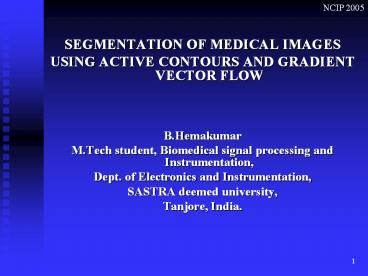SEGMENTATION OF MEDICAL IMAGES
Title:
SEGMENTATION OF MEDICAL IMAGES
Description:
SEGMENTATION OF MEDICAL IMAGES USING ACTIVE CONTOURS AND GRADIENT VECTOR FLOW B.Hemakumar M.Tech student, Biomedical signal processing and Instrumentation, – PowerPoint PPT presentation
Number of Views:363
Avg rating:3.0/5.0
Title: SEGMENTATION OF MEDICAL IMAGES
1
- SEGMENTATION OF MEDICAL IMAGES
- USING ACTIVE CONTOURS AND GRADIENT VECTOR FLOW
- B.Hemakumar
- M.Tech student, Biomedical signal processing and
Instrumentation, - Dept. of Electronics and Instrumentation,
- SASTRA deemed university,
- Tanjore, India.
2
OUTLINE OF PRESENTATION
- Active contours
- Introduction
- Applications
- Problems conventional snakes
- Existing Methods
- GVF Method
- GVF snake
- Results
- Conclusion
3
ACTIVE CONTOURS
Active contours -- or snakes -- are
computer-generated curves that move within images
to find object boundaries Curves defined within
an image domain that can move under the influence
of internal forces within the curve itself and
external forces derived from the image data
4
ACTIVE CONTOURS contd
- Basic idea MODELLING
- MODEL evaluated based on INT EXT properties
- MODEL can move, shrink and expand
- 3 Forces govern the motion of SNAKE
- Int. forces
- Ext. forces
- Image forces
5
APPLICATIONS
- CARDIAC DISORDERS
- CC GOLD STANDARD
- Role of Active contour
- PROSTATE CANCER
- Biopsy
- Role of Active contours
6
PROBLEMS WITH CONVENTIONAL SNAKES
- Snakes cannot move toward objects that are too
far away - Snakes cannot move into boundary concavities or
indentations
7
EXISTING METHODS
- Multiresolution methods have addressed the issue
of initialization, but specifying how the snake
should move across different resolutions remains
problematic - Pressure forces, can push an active contour into
boundary concavities, but cannot be too strong or
weak edges will be overwhelmed - Distance potential forces
- Control points
- Solenoidal external fields
8
EXISTING METHODS contd..
- Previous efforts to solve these problems have
not been completely successful, and have often
created new problems along with the proposed
solutions.
9
GVF METHOD
We present a new class of external forces for
active contour models that addresses the problems
listed previously. The GVF forces are used to
drive the snake, modeled as a physical object
having a resistance to both stretching and
bending, toward the boundaries of the object.
The GVF forces are calculated by applying
generalized diffusion equations to both
components of the gradient of an image edge map.
10
GVF METHOD contd..
Because the GVF forces are derived from a
diffusion operation, they tend to extend very far
away from the object. This extends the "capture
range" so that snakes can find objects that are
quite far away from the snake's initial
position. This same diffusion creates forces
which can pull active contours into concave
regions.
11
RESULTS
We have developed a graphical user interface
(GUI) using MATLAB 6.1 MRI and ultrasound
Imaging were done at Govt. General hospital,
Karaikal. We have tested our GVF snake on many
types of objects, from simple shapes to magnetic
resonance images of the heart and brain, renal
and prostate cancer ultrasound images
12
RESULTS contd.. (GUI)
13
RESULTS contd..
- MRI images of Heart
Ultrasound images of the prostate cancer
14
CONCLUSION
The GVF snake is a new approach to active
contours and surfaces. It focuses on the design
of the external force first, and the
implementation of the snake second. The
computations are straightforward, i.e., the
diffusion equations are simple to calculate, and
the result is always better than the traditional
snake.
15
KEY REFERENCES
- Chenyang Xu and Jerry L. Prince, Gradient Vector
Flow A New External Force for Snakes, IEEE
Proc. Conf. on Comp. Vis. Patt. Recog. (CVPR'97) - http//iacl.ece.jhu.edu/projects/gvf/
- 3. P. Abolmaesumi, SEGMENTATION OF PROSTATE
CONTOURS FROM ULTRASOUND IMAGES, IEEE Trans.
Med. Imag., vol. 22, no. 4, pp. - 539551, 2003
16
ACLNOWLEDGEMENT
- Dr. G. BALACHANDIRAN,
- M.B.B.S., M.D., D.M.R.D., DNB, M.I.C.R.,
- HEAD OF DEPARTMENT,
- Dept. of Radiology,
- Govt. General Hospital,
- Karaikal.
17
THANKS FOR YOUR ATTENTION































